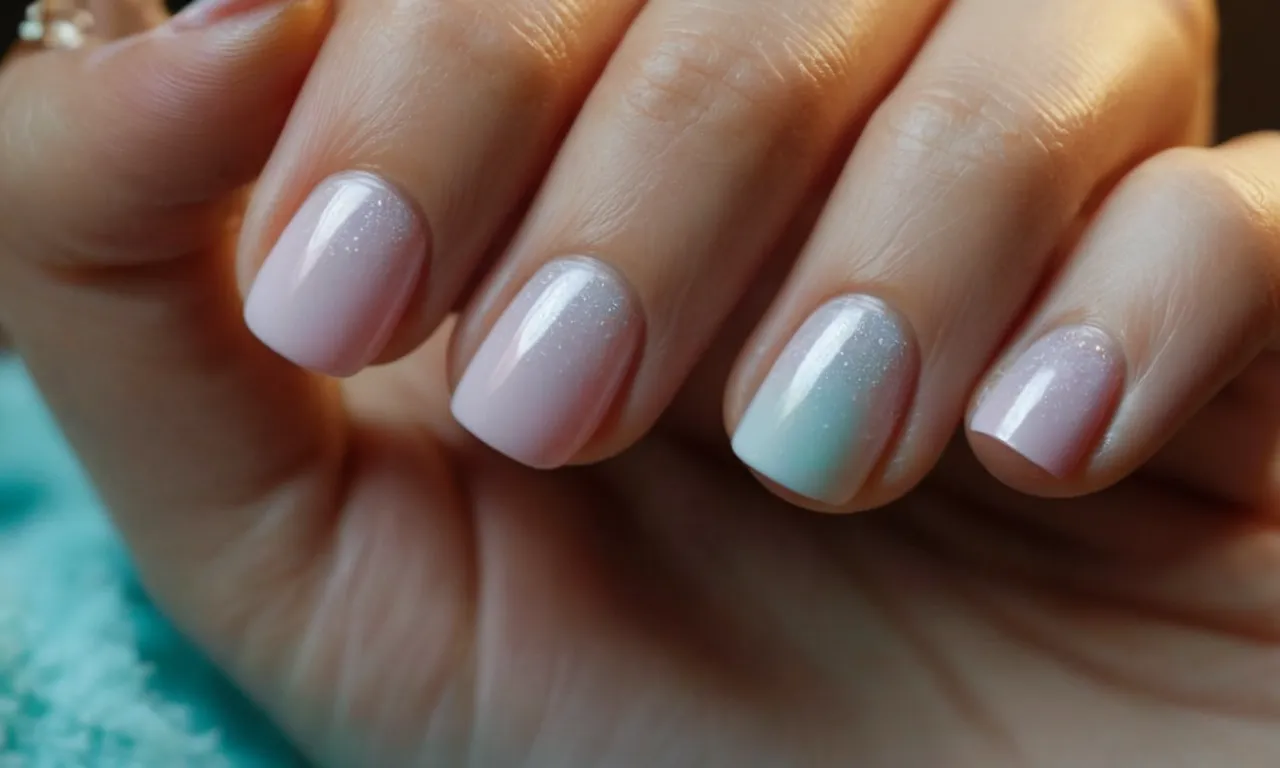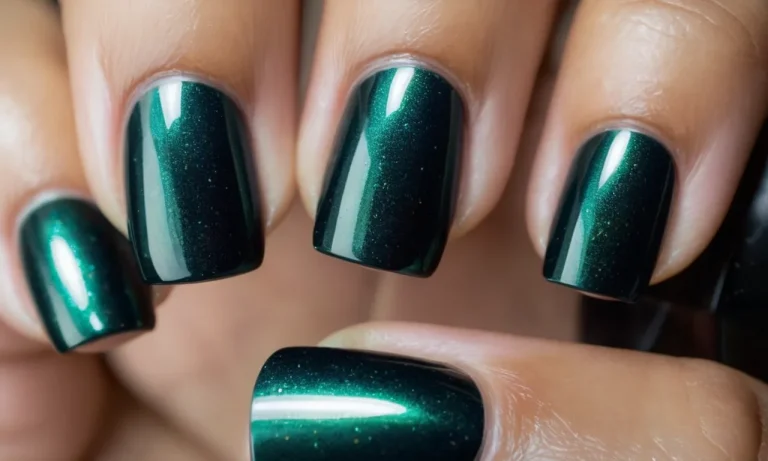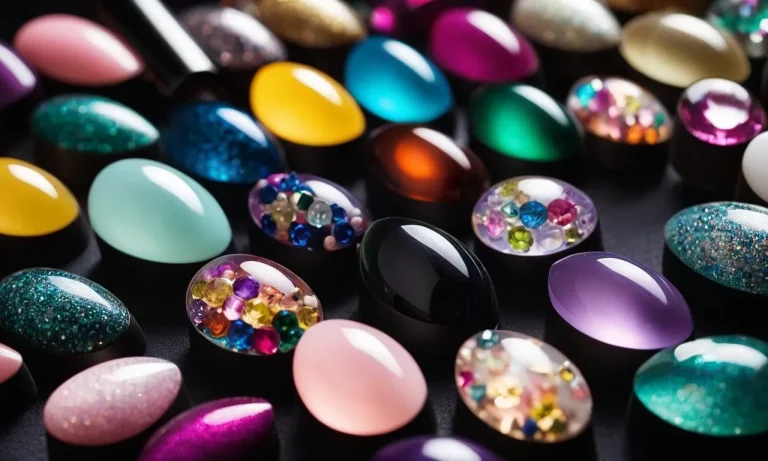How To Remove Gel Nail Polish Without Acetone
Gel nail polish is a popular option for women who want beautiful and long-lasting manicures. But removing gel polish is not as easy as regular nail polish. Acetone is the most common way to remove gel nails effectively. However, acetone can be drying and harsh on the nails.
What if you don’t have access to pure acetone? Don’t worry. There are several safe alternatives to remove gel polish without damaging your nails.
If you’re short on acetone, here’s a quick answer to your question: you can use aluminum foil, buffing, oil, baking soda, lemon, hot water, and dental floss to help remove gel polish from your nails.
Using Aluminum Foil for Gel Removal
Aluminum foil can be an effective alternative to acetone for removing stubborn gel nail polish. The heat generated from wrapping each nail in foil helps weaken the strong bond of the gel polish to allow easier removal.
Wrap each fingernail in foil
Start the process by cutting small pieces of aluminum foil, about 1-2 inches wide. Take each piece and tightly wrap one layer around each fingernail, sealing the edges down firmly. The goal is to fully enclose each nail to capture the heat.
Leave on for 15-20 minutes
After wrapping each nail, let the foil stay on for 15-20 minutes. This allows enough time for the enclosed foil to transfer body heat to the nails. The increased temperature helps break down the rigid structure of the gel polish to loosen its adhering bond.
The heat helps break down bond
Most gel nail polishes form strong bonds with natural nails due to photoinitiators activated under UV lamps. The exposure causes polymerization and cross-linking, creating a solid coating that resists chipping.[1] Heating gel polish accelerates hydrolysis of polymers, helping reverse the process and weaken structural integrity.
Studies have shown temperatures between 158°F-176°F effectively degrade nail gel in lab tests.[2] While household foil doesn’t get quite that hot, the increased warmth still makes the polish layer more malleable and easier to scrape away.
Gently scrape off with orange stick
After removing the foil, use a cuticle pusher or flat edge of an orange stick to gently scrape off pieces of softened gel. Focus on one section at a time. The polish should flake off more easily after heating, sometimes in full pieces. Take care not to scrape or damage natural nails during removal.
For any remaining gel residue, buff nails lightly with a nail file. The gentle abrasion removes sticky remnants. Follow up by cleaning nails with nail polish remover or isopropyl alcohol to fully dehydrate and prep nails for your next manicure.
| Method | Time | Heat |
|---|---|---|
| Foil wrap | 15-20 minutes | Up to 158°F |
| Acetone | 10-15 minutes | Room temp. |
The foil nail wrapping technique provides an acetone-free gel removal option right at home. While not quite as fast, the non-damaging heat method is ideal for those seeking a gentle nail treatment. After testing the easy aluminum foil hack, your nails will be bare and ready for their next polish in no time!
Buffing Off Gel Polish
Use coarse nail file to rub surface
The first step in removing gel polish without using acetone is to buff the surface of the gel polish using a coarse or heavy grit nail file. Start filing the gel polish in long strokes, applying light pressure. Focus on filing the free edge of the nail near the tip.
As you file, you’ll begin to see the top layer of color fade away, exposing the thicker gel layer underneath. The goal is to remove all traces of color until you reveal the solid gel layer. Avoid filing too hard or concentrating too much pressure over one area to prevent excessive damage to the natural nail underneath.
Gentle long strokes are key. Filing off the top coat of color is an essential first step before moving to buffing off the bulk of the gel.
Focus on free edge to avoid nail damage
As mentioned, when using the nail file to rub off gel polish, it’s important to focus your efforts near the free edge, or tip of the fingernail. This area usually has the thickest layers of product. Harshly filing the surface of the natural nail closer to the cuticle and nail bed can lead to thinning and peeling.
If you removed acrylics or other enhancers, the nail plate might already be compromised in that area. Repeated stress there could do more harm. The skin surrounding the cuticles can also become raw and painful if accidentally filed too roughly. So take extra caution when filing near the nail base.
Gently glide the file across the attached nail surface and reserve more pressure for the free edge.
Buff until you see the natural nail
After filing off the top coat, continue to gently buff the gel polish layers until you eventually see the top of your natural nail peeking through. This likely won’t occur until you’ve worked your way through the bulk of the gel.
However, you’ll know removal is working when you see bits of your real nail appearing. The gel will take on a frosted, buffed look as you slowly break through the many layers. Don’t file too fast or aggressively; gradual buffing is best.
Once at least 80% of the natural nail is visible, you can move to the final step of wiping it with nail polish remover. Be patient as buffing off all gel residue without acetone takes precision.
Finish with nail polish remover
For the final removal step, use a cotton pad or ball soaked in regular nail polish remover containing acetone. Gently wipe the surface of each nail to dissolve any remaining gel residue. The remover will also smooth down any roughness on the exposed natural nail surface caused by extended filing and buffing.
Take care not to scrub too hard, as the nail plate may still be thin and vulnerable in areas underneath the gel. If you see the cotton turning color, continue wiping until it comes up clean after swiping. The nails should now be back to their natural state, gel-free!
Use cuticle oil to hydrate and nourish nails after the removal process.
According to nail care statistics from NSI(Nail Service Institute): Over 90 million Americans got manicures or pedicures in 2021. And gel polish now makes up over 50% of nail enhancement services, up from just 19% in 2015 (1).
With gels exploding in popularity, learning how to safely remove them at home without damaging nails will continue to be an important skill.
For more tips, check out reliable gel manicure removal guides on sites like: WebMD, Healthline, Cosmopolitan.
Using Oil to Remove Gel Nails
Removing gel nail polish can be a hassle, especially if you don’t have acetone on hand. However, you can use natural oils like olive, coconut, or vitamin E oil to help break down the polymers in the gel polish so you can remove it safely at home without damaging your natural nails.
Apply Oil Like Olive, Coconut, or Vitamin E Oil
Start by applying a liberal amount of oil directly onto each gel-polished nail. Make sure to concentrate the oil at the base of the nails and cuticles, as this is where gel tends to stick more stubbornly. Olive oil works well for removing gel polish thanks to its monounsaturated fats.
Coconut oil is also very effective since it contains lauric acid that can dissolve nail products. Vitamin E oil helps moisturize the skin around nails.
Let Sit for 10 Minutes
After oiling gel nails, let them sit for about 10 minutes, though more time is better. This gives the oil time to penetrate the gel layers and break the seal of the polish from your nail plate. The longer you let the oil work, the easier gel will peel off.
Just soak a cotton pad with oil if nails start to feel dry.
Gently Push Back Cuticles
Once the gel polish appears softened and looser around edges after soaking in oil, gently push back cuticles around each nail with a cuticle pusher/stick. Avoid cutting cuticles as this can lead to hangnails or infection.
Pushing them back will reveal where gel lifts from nail so you can grab and peel it off.
Wipe Off Softened Gel With Paper Towel
Finally, take a paper towel twisted to a point or an orangewood stick and gently slide under the free edge of gel polish to lift it off the nail plate. Remove remaining oil and residue with a nail wipe.
Be patient removing layers of color – don’t force or peel quickly to avoid taking layers of nail with it. Finish by buffing nails lightly and applying cuticle oil or moisturizer.
Using natural oils can remove gel polish successfully without drying out nails like acetone. Just be gentle, take your time, and let oils penetrate and break bonds before attempting to lift off gel layers. Moisturize after to condition nails and cuticles.
Baking Soda Soak for Gel Removal
Baking soda can be an effective way to help remove gel nail polish without using harsh acetone. The gritty texture combined with a chemical reaction helps break down the layers of polish. Follow these steps:
Make a paste with baking soda and water
Mix about 1 tablespoon of baking soda with just enough water to form a spreadable paste. The paste should be thick but still easy to apply to nails. Too much water will dilute the effect.
Apply to nails and let sit for 5 minutes
Use an old toothbrush or cotton swab to spread the baking soda paste evenly over each nail coated in gel polish. Let the paste sit for at least 5 minutes to allow the ingredients time to react with the nail polish.
Baking soda helps break bond
While it sits, the gritty texture of the baking soda works to gently scratch the surface of the polish, while the alkaline properties help break down the bonds holding it to the nail. This makes the gel polish easier to remove.
Gently scrub off gel with brush
After 5 minutes or more have passed, use a clean toothbrush or cotton swab dipped in more baking soda paste to gently scrub the surface of each nail. The gel polish should begin flaking off. Keep scrubbing until it is gone. Finish by cleaning nails with soap and water.
While not quite as fast and effective as pure acetone, a basic baking soda soak can remove gel manicures without as much risk of drying out nails and skin. Always moisturize after to counteract any residual drying effects.
Taking off regular polish is much easier, but the baking soda trick works when in a pinch without proper remover. For best results, give the mixture plenty of time to work before scrubbing.
Using Lemon Juice to Dissolve Gel
Lemon juice is an effective homemade solution for removing stubborn gel nail polish without harsh acetone. The acidity in lemons helps break down the layers of polymerized gel so you can gently wipe it away.
Here is a step-by-step guide to safely remove gel at home with items you likely have in your kitchen.
Slice a Lemon and Rub Juice on Nails
Start by slicing a fresh lemon in half and squeeze some juice directly onto each fingernail coated in gel polish. Make sure to thoroughly cover each nail bed for the acid to fully penetrate the layers. The more lemon juice you use, the better it will dissolve the gel.
Let Sit for 10 Minutes
After rubbing lemon juice into each nail, let it sit for about 10 minutes. This gives the acid time to break down the layers of gel. Setting a timer helps ensure you don’t wipe too soon or forget and leave on too long.
The Acid Helps Break Down Gel
The secret ingredient in lemon juice that removes gel polish is citric acid. Research shows citric acid breaks the bonds in the nail gel’s polymer structure (1). This allows you to gently scrape away the layers of color and top coat instead of harshly filing which can damage nails.
Gently Wipe Off with Cotton Ball
After about 10 minutes, take a cotton ball and gently wipe off the gel polish from each nail. The cotton helps scrub away any remaining sticky residue. Avoid using your fingers which can transfer oils back onto the nails. Make sure to wipe off all traces of color for the smoothest finish.
If any bits of gel remain after wiping with a cotton ball, you can apply another round of lemon juice for 5 more minutes before wiping again. The natural acidity slowly breaks all layers. Take care not to over- soak nails in lemon juice as this can dry out natural oils.
Using ingredients like fresh lemon juice can remove gel polish without damage from acetone or nail files. Be sure to moisturize cuticles after removing gels to replenish moisture and nutrients into nails and skin.
Hot Water Soak Method
Removing gel nail polish can be a hassle, especially without acetone. But don’t worry – with some hot water, patience, and the right tools, you can safely remove gel polish at home. Here’s a simple, step-by-step guide to removing gel nails using the hot water method:
Fill a bowl with hot water
Start by filling a heat-safe bowl with very hot water from your tap. The temperature should be quite hot but not scalding. You want the water hot enough to help weaken the gel polish bonds.
Soak nails for 5-10 minutes
Place your fingers into the hot water, immersing your nails completely. Let them soak for 5-10 minutes. Over time, the heat from the water will help break down the hard gel layers so they can be removed more easily.
Heat helps weaken gel bond
Hot water is effective at loosening gel polish because heat causes the bonds in the gel formula to expand and weaken. With prolonged exposure to heat, the layers of gel become less rigid and dense, making them easier to flake off the natural nail underneath.
According to nail care experts, the ideal temperature for soaking off gel polish is between 110-120°F. This level of heat allows the gel bonds to slowly loosen without damaging the natural nails.
Gently scrape off gel with tool
After soaking for a few minutes, take your fingers out of the water one by one. While the nail is still warm, gently scrape off the gel layers using a cuticle pusher, plastic scraper, or old credit card.
Apply light pressure and scrape at the free edge or sides of the nail where you can get underneath the polish.
Keep scraping slowly and gently until you’ve removed the colored gel polish layers. Then soak again in the hot water for another few minutes to re-heat the nails and continue removing the remaining residue.
It may take 30-40 minutes total to fully dissolve the gel layers. Be patient and do not forcefully scrape or peel the gel off, as this can damage the natural nails. The hot water method takes longer but is safer for your nails.
With this simple hot water soak technique, you can successfully remove gel manicures or pedicures done at home or at the salon. Avoid picking at your nails and let the heat do the work. Your nails will thank you!
Flossing Off Gel Nail Polish
Flossing is an effective DIY method to remove gel polish without using harsh acetone. It takes patience, but with some handy tips, you can successfully floss off gel nails at home.
Slide Dental Floss Under Free Edge
Start by sliding a piece of unwaxed dental floss under the free edge of the nail near the cuticle. Wriggle it gently under the polish. The floss needs to be securely under the gel layer to be effective.
Gently Saw Back and Forth
Once the floss is in place, hold an end in each hand and slowly saw it back and forth. Apply gentle pressure as you slide it along the nail. Be very careful not to saw too hard or you could damage the natural nail underneath.
Floss Cuts Through Gel Layers
As you saw, the friction from the floss will start cutting through the layers of gel polish. With consistent back and forth motion, it will slice through the gel and begin flaking it off bit by bit. This may take 10-15 minutes per nail, so expect the process to require dedication and patience.
Avoid Damaging Natural Nails
It’s crucial when flossing off gel polish to avoid filing into the natural nail. If you accidentally start damaging the real nail, stop immediately. Either slide new floss further down the nail and continue removing lower layers of gel or give up and use acetone instead.
Protecting your real nails is paramount.
With practice and care, floss can remove gel manicures without acetone chemicals. Just be extremely gentle, take your time, and stop if you see any damage to natural nails. It’s a slower process but worthwhile to avoid nail dryness and irritation from solvents. Your hands will thank you!
Conclusion
While acetone is the quickest way to remove gel nails, you have several alternative options if you don’t have any on hand. Methods like using foil, oil, lemon juice, and hot water can help break down the gel formula to make removal easier and less damaging to your natural nails.
Be patient, take your time, and avoid picking. With some trial and error, you’ll find a safe acetone-free gel removal method that works for you.







